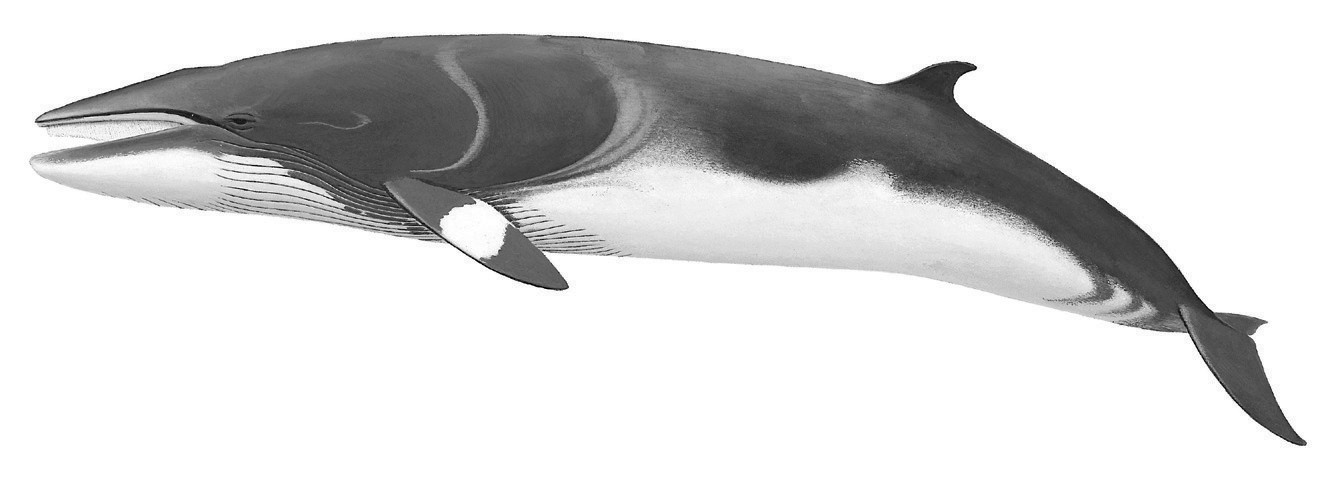COMMON MINKE WHALE
Balaenoptera acutorostrata Lacépède 1804
Order Cetacea : Family Balaenopteridae
DESCRIPTION. Smallest of the baleen whales in the Gulf of Mexico, adult common minkes may reach only 10 m in length and 9 metric tons in weight. As with all baleen whales, females are slightly larger than males of comparable age. Minke whales have a very narrow and pointed rostrum and a broad white band on the dorsal surface of the flippers. The triangular-shaped head has a single median ridge extending anteriorly from the blowholes to the tip of the snout. Coloration is dark gray to black above and white below. The baleen plates are yellowish white or cream colored. The dorsal fin, on the posterior third of the back, is tall and falcate, and the throat grooves end just beyond the flippers.

DISTRIBUTION. Minke whales are widely distributed, from the tropics to the ice edge in both hemispheres. In the North Atlantic, they are known to migrate from their high-latitude summer grounds to tropical latitudes during the winter. Minke whales are the most numerous of the baleen whales. The only record from Texas is a single stranding from Matagorda Peninsula on 29 March 1988.
SUBSPECIES. Balaenoptera a. acutorostrata.
HABITS. As with most other baleen whales, common minke whales tend to be highly migratory and move to cold temperate and polar waters in spring and then return to warmer waters in autumn. The movements of minke whales in the North Atlantic are heavily influenced by spawning concentrations of capelin, on which they feed. Also, seasonal segregation by sex and age is pronounced in these whales. Mature males tend to migrate farther north in spring and summer than do females and immatures.
Minke whales feed on krill, fishes (including sand lance, sand eel, salmon, capelin, mackerel, cod, coalfish, whiting, sprat, wolffish, dogfish, pollock, haddock, and herring), and squid. Capelin is the dominant food item of North Atlantic minkes.
Although baleen whales are generally thought incapable of echolocation, minke whales are known to produce a variety of sounds that include narrow-band pulses suitable for echolocation. Such sounds are described as a series of clicks and may aid in locating food concentrations. Other sounds of these whales are described as grunts, pings, zips, ratchets, and clicks.
In the North Atlantic, mating occurs from October to March. Females give birth to a single calf annually in early winter. The gestation period is about 10 months. Newborn minke whales are 2.4–2.7 m in length, and the lactation period is 4–5 months. Age at sexual maturity is approximately 6 years for males and 7 years for females.
POPULATION STATUS. Rare; strandings. There are 10 reliable records, all of them strandings, of common minke whales in the northern Gulf of Mexico. No live minke whales have been sighted in the Gulf. Most of the reports are from the Florida Keys, although strandings in western and northern Florida, Louisiana, and Texas also have been reported. Most cetologists believe these records represent strays from low-latitude summer grounds elsewhere in the western North Atlantic, but the possibility of a resident population in the Gulf cannot be totally dismissed.
CONSERVATION STATUS. Common minkes are not listed by the USFWS or the TPWD as either endangered or threatened. The IUCN lists it as a species of least concern because estimates from parts of the range in the northern hemisphere (totaling in excess of 100,000 individuals) show that it is well above the thresholds for a threatened category. Although declines have been detected or inferred in some areas, there is no indication that the global population has declined to an extent that would qualify for a threatened category.
REMARKS. The minke whale that stranded on the Texas coast was an immature female that was alive when first observed. It not only was the first of its kind known for Texas, but its physical features were also particularly interesting in that the white bands usually present on the dorsal surface of the flippers were absent and the baleen plates were partially black and numbered only approximately 240 per side. Typically, minke whales have about 300 baleen plates on each side of the mouth and they are cream white in color. These features initially caused confusion in the identification of the whale; however, measurements of the tympanic bullae confirmed that it was, indeed, a minke whale.
From The Mammals of Texas, Seventh Edition by David J. Schmidly and Robert D. Bradley, copyright © 1994, 2004, 2016. Courtesy of the University of Texas Press.
Natural Science Research Laboratory
-
Address
Museum of Texas Tech University, 3301 4th street, Lubbock, TX 79409 -
Phone
806.742.2486 -
Email
nsrl.museum@ttu.edu

